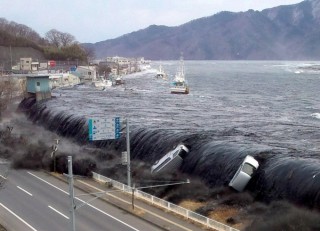Loading
Search
▼ Japan Issues New 'Megaquake' Warning
- Category:Other
The Japanese government has warned of catastrophic economic damage and nearly 300,000 deaths when the next "megaquake" hits the archipelagic nation, according to a new estimation released on Monday.
Why It Matters
Japan lies along the circum-Pacific seismic belt, better known as the "Ring of Fire," located along the outer edges of the Pacific Ocean, where about 81 percent of the largest earthquakes in the world occur, according to the U.S. Geological Survey.
Quake-prone Japan's four main islands and its outlying islands sit on five major and minor tectonic plates on the Earth's crust—Amur, Okhotsk, Pacific, Philippine Sea, and Okinawa—which are slowly moving, and earthquakes are concentrated along their boundaries.
On March 11, 2011, the 9.0-magnitude Great East Japan Earthquake struck the country, making it the largest earthquake ever recorded in Japan. The unprecedented disaster triggered a tsunami and caused a nuclear accident, killing at least 19,729 people.
What To Know
In the latest report prepared by a Japanese government earthquake task force, it was estimated that up to 298,000 people could be killed in a Nankai Trough megaquake with a magnitude of 8-9. The casualties would include 215,000 deaths caused by tsunami waves, the report said.
The Nankai Trough is an oceanic trench located off the southern coastline of the Japanese mainland. It is located at the triple boundary between the Amur, Okhotsk and Philippine Sea plates. The 2011 earthquake occurred in the nearby Japan Trench.
A Nankai Trough earthquake has struck Japan every 100 to 150 years—and experts have long feared that another could hit there in the near future. The last confirmed temblors linked to the trough were recorded in 1944 and 1946, hitting the country's central to southwestern region.
At nearly 300,000, Tokyo's current estimate of the potential loss of life is down by 10 percent from the previous report released in 2012, while projected economic losses rose to $1.8 trillion from $1.4 trillion.
There is a 70-80 percent chance of a megaquake occurring within 30 years, the Japanese government estimated. In a worst-case scenario, some regions could experience the highest level of 7 on Japan's seismic intensity scale, as well as tsunami waves rising over 98 feet, according to official estimates.
The highest level of Japan's seven-number scale will make it impossible for people to remain standing, while buildings that have low resistance to earthquakes will collapse, according to the Japan Meteorological Agency.
The release of the Japanese megaquake report comes after a magnitude-7.7 earthquake hit Myanmar on Friday, causing tens of thousands of deaths, according to U.S. estimates.
A series of earthquakes occurring in 24 hours in Asia last week also revived discussions about the Japanese comic book The Future I Saw, a recording of the cartoonist author's dreams published in 1999. The manga was later called a "prophecy" after readers discovered that it apparently had predicted the 2011 earthquake.
Debate rose again over the book's complete edition, in which the cartoonist dreams of a catastrophe in July 2025. In the comic, the disaster leaves one-third of Japan's territory submerged following an "eruption" of the seabed between Japan and the Philippines, causing a giant tsunami three times as large as the one that struck in 2011.
Ten of 15 prophecies mentioned in the comic are interpreted to have come true, according to Taiwanese magazine Global Views Monthly. Among them appeared to be the COVID-19 pandemic.
What People Are Saying
Nobuo Fukuwa, professor emeritus at Nagoya University and a member of the government's earthquake task force: "Unless damages are reduced, there are concerns about the nation's future. We want [the government] to take countermeasures more seriously."
U.S. Geological Survey, in the frequently asked questions about natural hazards: "[Japan] is in a very active seismic area, and they have the densest seismic network in the world, so they are able to record many earthquakes."
The Hong Kong Observatory in a recent update: "Globally, statistical data indicates that approximately 20 earthquakes of magnitude 7 or above occur each year, but the exact timing, location, and magnitude of these events remain unpredictable."
What Happens Next
Japan's Kyodo News said that the Japanese government will revise the "disaster prevention plan" to designate additional priority regions based on the expanded flood risk zones, as the report highlighted the importance of swift evacuation in the event of a tsunami.
- April 3, 2025
- Comment (0)
- Trackback(0)


